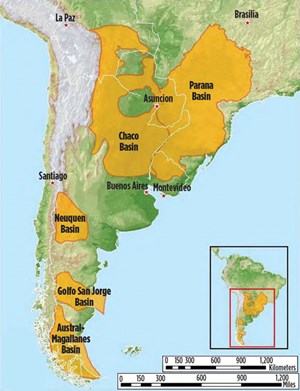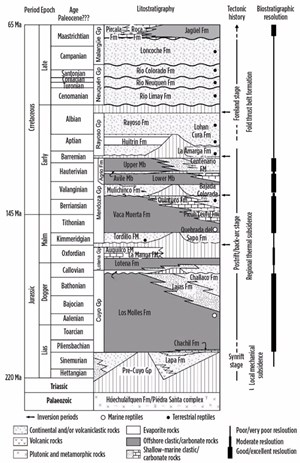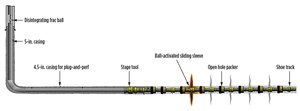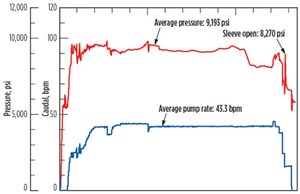Shaletech Report: Completion Methods
The vast shale oil and gas resources of Argentina’s Vaca Muerta formation in the Neuquén basin were first tapped in 2010. Since then, operators have been trying to increase production while reducing well costs. They have experimented with both vertically and horizontally oriented wellbores, hydraulic fracturing, increased wellbore segmentation, and various completion techniques.
As of third-quarter 2015, a vertical well cost an average $7 million, and a horizontal well cost $14 million—significantly more than the goal of $4 million to $5 million, but decreasing steadily from initial well costs.1 During the same timeframe, the average initial 30-day production rate of an individual well (IP30) was 646 boed, up from 443 boed in 2014.2 For comparison, the average Eagle Ford shale well costs $4 million to $5 million and has an IP30 rate of 840 boed. While efficiencies have been gained as operators experiment with methodologies, wells targeting the Vaca Muerta shale must become more economical, if Argentina is to have its own unconventional shale revolution.
A significant portion of the total well cost is both directly and indirectly affected by the completion method. The completion technique also impacts how effectively the reservoir is stimulated, and, as a result, the well’s productivity. By adopting a customized completion solution, involving a combination of proven unconventional completion technologies, in Argentina’s longest horizontal lateral to date, an operator targeting the Vaca Muerta shale was able to achieve the highest initial production rate ever seen in the country. This well will serve as a blueprint for subsequent wells, as Argentine operators turn to large-scale field development to ramp up production and drive down costs.
BACKGROUND
Reservoir overview. Argentina has some of the most promising shale oil and gas resources in the world, with the majority of those resources located within the Neuquén basin, which spans an area of 66,900 mi2 to the east of the Andes mountains3 as shown in Fig. 1.
As a whole, Argentina contains 802 Tcf of technically recoverable shale gas and 27 Bbbl of technically recoverable shale and/or tight oil, the second- and fourth-highest resource amounts in the world, respectively.5 The Neuquén basin contains 73% of the country’s technically recoverable shale gas and 74% of its shale oil.
Within the Neuquén basin there are two major shale formations, Los Molles and Vaca Muerta, as seen in Fig. 2. Vaca Muerta, alone, holds 38% of the country’s technically recoverable shale gas and 60% of its technically recoverable shale oil resources. The Vaca Muerta shale is found at a depth of about 9,500 ft and has a pay zone that is substantially thicker than that of comparable shale plays, ranging from 200 ft to 1,700 ft in thickness.3,5
Because of its thickness, Vaca Muerta has been produced successfully in the past from vertical wells; however, horizontal wells increase reservoir contact, which has been proven to increase production from this prolific reservoir.
Historical completion methods. Between 2010 and 2014, the majority of wells drilled in Vaca Muerta were vertical and hydraulically stimulated, with four to six stages using plug-and-perf (PnP) technology, which will be discussed in the following section. In 2014, operators started adopting horizontally oriented wellbores on a larger scale. About 14% of the new wells drilled in 2014 were horizontal.
During this same timeframe, stage count remained constant at four to six stages, and the completion method of choice continued to be PnP. In 2015, 37% of new wells drilled were horizontal, and operators started taking advantage of longer lateral sections with increased stage count for more targeted stimulation. Typical lateral lengths increased to 4,900 ft, bringing measured depths of many horizontal wells to about 14,400 ft.
Stage count in vertical wells remained constant at four to six stages; however, stage count in horizontal wells increased to an average of 15 per well. Although the majority of the 460 wells currently producing in Vaca Muerta2 are low-stage-count vertical wells, stimulated with PnP technology, other multi-stage completion methods, including ball-activated sliding sleeves, are being adopted to alleviate the challenges of PnP completions in extended-reach horizontal wellbores.
TECHNOLOGY
The goal of all multi-stage completion methods is to perform three functions:
- Allow access to the reservoir on a selective basis.
- Provide tubing isolation between zones, as they are stimulated.
- Provide annular isolation between zones, as they are stimulated.
Each completion method has advantages and disadvantages that lead operators to choose one method over another, or even combine methods in a hybrid style completion.
Plug-and-Perf is the oldest, most widely used, unconventional multi-stage completion method. This method uses frac plugs, in conjunction with cement, to isolate between stages and perforating guns to gain access to the reservoir rock.
In a PnP operation, casing is first installed and cemented over the productive zone. When stimulation is ready to begin, a frac plug, typically made of composite material, is attached below perforating guns and the entire assembly is run to the bottom of the wellbore on wireline. The frac plug is set in the casing and released using a wireline charge. The perforating gun assembly is then pulled up-hole.
Perforating gun charges are activated, using wireline, and holes are shot through the casing and cement to gain access to the reservoir. The number of perforation sets in a single stage varies, but three is typical. Once all guns have been fired, assembly is pulled out-of-hole and the fracturing treatment can begin. After treatment of the zone, a new plug and perforating guns are run into the wellbore to just above the previously stimulated zone, and the process begins again. After all zones are stimulated, the frac plugs must be milled out, using coiled tubing to clear the wellbore for production.
One main advantage of PnP is the flexibility that it affords when determining where to stimulate. Operators can determine where to place their fracturing treatment on the fly, since frac plugs can be placed anywhere in the casing string. A disadvantage is the necessity of using coiled tubing to mill out plugs after stimulation, since it has limited reach. Milling may not be an option for some extended reach wells, due to this limiting factor.
Ball-activated sliding sleeves. Ball-activated sliding sleeves became popular in North America during the unconventional shale boom. This method uses increasing sizes of frac balls and ball seats, in conjunction with cement or open-hole packers, to isolate between stages, while sliding sleeves provide a single point of access to the reservoir rock.
Frac balls can be made of either composite material or disintegrating metal that enables the ball to disintegrate in wellbore fluids. In a ball-activated, sliding sleeve operation, sleeves are installed from smallest to largest ball seat, in line with casing over the productive zone. For open-hole applications, open-hole packers also are installed in line with the casing. For cemented applications, no open-hole packers are necessary, as the cement provides annular zonal isolation.
When stimulation is ready to begin, the smallest ball is dropped into the wellbore and sits on its respective ball seat, in the bottom-most sleeve of the wellbore. Pressure is built against the seal created by the ball on seat, and the sliding sleeve opens, exposing frac ports with access to the formation. Stimulation is ready to begin. Once the treatment for the zone is complete, the next largest ball is dropped into the wellbore, and it seats on the next sleeve up. After the entire wellbore has been stimulated, the frac balls disintegrate in wellbore fluids.
One advantage of ball-activated sliding sleeve systems is the increased operational efficiency, since downtime between stages is only as long as it takes to drop a ball. Another advantage is the elimination of coiled tubing milling, since the wellbore restrictions disintegrate after stimulation. As a result, this method is ideal for extended-reach wellbores, where coiled tubing milling is not an option. A disadvantage is the fact that sleeve placement, and thus the stimulation point, is set when casing is installed, and it cannot be altered during fracturing treatment.
HYBRID COMPLETION DESIGN
Customer challenge. A major operator in Argentina wanted to drill, complete and hydraulically fracture the longest horizontal lateral, to date, in Argentina. This extended-reach well in the Vaca Muerta shale had a lateral length of 6,614 ft and a measured depth of 17,493 ft. Performing PnP throughout the entire wellbore was not an option, since the measured depth of this well was beyond the reach of coiled tubing units in Argentina.
The operator also wanted to increase stage count to 28 while improving operational efficiency—two factors that work against one another. Typically, as stages increase, treatment time and completion costs also increase. Additionally, it was important to minimize over-displacement of fluid into the reservoir during the fracturing treatment, which is a common practice with many multi-stage completions. The goal was to find the optimal well design to implement for large-scale field development that would both maximize production and minimize costs.
Customized solution. To address the operator’s challenges, a hybrid long-string system of both PnP and open-hole, ball-activated sliding sleeves was devised. The lower section of the lateral that was beyond the reach of coiled tubing would contain 13 stages of open-hole, ball-activated sliding sleeves that utilized disintegrating frac balls. Then, 15 stages of composite plugs for PnP were planned in the remaining portion of the lateral, at depths where coiled tubing milling was feasible.
To deploy both completion methods in a single lateral, the lateral would need to be partially open-hole and partially cemented, which was accomplished with the use of a stage tool. Additionally, two different sizes of casing were used in the cemented section, and were cemented to surface. Although the nature of this hybrid completion was inherently challenging, using both completion methods in a single well allowed the operator to compare the operational advantages and disadvantages of each method, for use in future field development.
From top to bottom, the well was arranged as follows:
- Cemented: 5-in. casing from surface through kick-off point and into lateral.
- Cemented: Crossover from 5-in. casing to 4.5-in. casing.
- Cemented: 4.5-in. casing to stage tool
- 15 stages of PnP, spaced evenly across 3,940 ft of lateral, utilizing 15 composite plugs and three perforations per stage.
- Cemented: Stage tool and debris sub to direct cement into annulus.
- Open-hole: Hydraulically-actuated open-hole packer to isolate cement.
- Open-hole: 4.5-in. casing to bottom
- 13 stages of ball-actuated sliding sleeves, from largest to smallest ball, spaced evenly across 2,625 ft of lateral, with hydraulically-actuated open-hole packers on either side of sleeve, all in line with casing.
- Open-hole: Shoe tracks.
A diagram of the completion design is shown in Fig. 3. Note that the diagram is not to scale, and does not represent all stages.
HYBRID COMPLETION INSTALLATION/STIMULATION
Leveraging torque and drag modeling, the entire string was run successfully to the bottom of the wellbore. A ball was dropped to the shoe track, and pressure was built to set the hydraulically-actuated open-hole packers and open the stage tool. A larger ball was dropped to the debris sub, to prevent cement from entering the ball-activated sleeve section of the lateral. Cement was pumped down the tubing string, through the stage tool, and up the annulus to surface and was chased with a wiper plug that closed the stage tool. The wiper plug, stage tool and debris sub were then drilled out, leaving a clear wellbore to begin fracturing operations.
Hydraulic fracturing operations were conducted on a 24-hr basis. With the hydraulic fracturing crew rigged up, pressure was applied to the string, to open the pressure-activated sleeve in the shoe track of the string. This established a flow path, so that the first and smallest ball could be pumped to the bottom-most ball-activated sliding sleeve. A pressure spike and pressure release like that shown in Fig. 4 was observed, indicating that the ball landed on the seat and the sleeve opened, exposing the fracturing ports. Although this completion system allowed for continuous pumping, pumps were shut down briefly before starting the fracturing treatment. After completing the stimulation of the first stage, the second smallest ball was dropped and landed in the second seat from bottom. This sequence was repeated successfully for all 13 sleeve stages.
For the ball-activated sliding sleeve stages, the hydraulic fracturing treatment was pumped at a rate of up to 45 bpm, with proppant concentrations of up to 4.5 ppg. Maximum fracturing pressure observed was 9,661 psi, and clear sleeve-shift pressure signatures were observed for 12 stages. For the stage without a clear signature, it was determined that the sleeve was open by correlating the volume pumped from the time the ball was launched with observed pressure fluctuations.
In all, 4.7 million lb of proppant were pumped into the 13 sleeve stages. All 13 stages were stimulated in 41 hr, with a single stage taking as little as 1 hr from the start of treatment to the following stage’s beginning of treatment.
After the open-hole portion of the well was stimulated, PnP operations commenced during daylight hours, only for the remaining 15 stages (stages 14–28). Each stage was stimulated at a rate of up to 60 bpm, with proppant concentrations up to 5.0 ppg. A total of 7.8 million lb of proppant was pumped into the 15 PnP stages, and all stages were stimulated in nine days. After stimulation, the composite frac plugs were milled out efficiently with a single mill, dressed with carbide.
No disintegrating frac balls were recovered at surface when the well was turned on to production, just over a month after the stimulation of stage 13 was complete. This indicates that all frac balls disintegrated downhole during that time period.
RESULTS
The well was turned on to production in October 2015 at an initial output rate of 1,630 boed—the highest ever in Argentina. The total cost of this well was in line with current horizontal well costs in Argentina. Yet, due to it’s experimental nature, the groundwork was laid for future use of ball-activated sliding sleeves and the hybrid method in the region. The success of this well has encouraged operators in Vaca Muerta to adopt extended-reach horizontal wells, while also increasing the stage counts.7
CONCLUSIONS
The major customer challenges were addressed by creating a customized solution that combined multiple completion methods. A summary of challenges and solutions is as follows:
The lateral was drilled beyond the reach of coiled tubing: Ball-activated sliding sleeves with disintegrating frac ball technology were used in the bottom portion of the lateral, so that more of the lateral could be stimulated without the need for milling.
Limit fluid over-displacement: Less fluid is necessary with ball-activated sliding sleeves, when compared with PnP, since only a ball must be pumped from surface. The amount of over-displacement with sleeves can be minimized, as experienced in the formation increases. For this well, water usage was reduced 165,108 gal for the 13 ball-activated sleeve stages, when compared to the PnP stages.
Increase operational efficiency: Ball-activated sliding sleeve stages were stimulated in a fraction of the time that PnP operations were completed. ![]()
ACKNOWLEDGEMENTS
This article was adapted from SPE paper 180976-MS, which was presented at the SPE Argentina Exploration and Production of Unconventional Resources Symposium, held in Buenos Aires, Argentina, June 1–3, 2016. The authors would like to thank Baker Hughes for the opportunity to publish this article, and the Baker Hughes field personnel for the safe execution of field operations at this well.
REFERENCES
1. Newbery, C., “At the wellhead: Struggles to cut cost delay oil play production in Argentina,” The Barrel, Aug. 15, 2015, http://blogs.platts.com/2015/08/17/cut-cost-delay-oil-play-argentina/ (accessed March 7, 2016).
2. Wood Mackenzie, “Vaca Muerta shale to double production by 2018,” World Oil, Nov. 24, 2015, http://www.worldoil.com/news/2015/11/24/vaca-muerta-shale-to-double-production-by-2018-wood-mac-says (accessed March 7, 2016).
3. EIA, Argentina, in Technically Recoverable Shale Oil and Shale Gas Resources: An Assessment of 137 Shale Formations in 41 Countries Outside the United States. Chap. V, 2013.
4. Kuuskraa V., S. Stevens, T. Van Leeuwen, K. Moodhe, “World Shale Gas Resources: An Initial Assessment of 14 Regions Outside the United States,” Report, U.S. Department of Energy, Washington D.C., April 2011, http://www.adv-res.com/pdf/ARI%20EIA%20Intl%20Gas%20Shale%20APR%202011.pdf (accessed March 13, 2016).
5. EIA, “World shale resource assessments,” Sept. 24, 2015, http://www.eia.gov/analysis/studies/worldshalegas/ (accessed March 13, 2016).
6. Howell, J. A., E. Schwarz, L. A. Spalletti and G. D. Veiga, The Neuquén Basin: An overview, The Geological Society of London, 252: 1–14. 10.1144/GSL.SP.2005.252.01.01.
7. Badessich, M. F., Hryb, D. E., Suarez, M., Mosse, L., Palermo, N., Pichon, S., Reynolds, L., “Vaca Muerta shale – Taming a giant,” Schlumberger Oilfield Review 28 (1): 26–39, http://www.slb.com/~/media/Files/resources/oilfield_review/ors16/Jan2016/04_Vaca_Muerta_Shale.pdf (accessed March 10, 2016).






